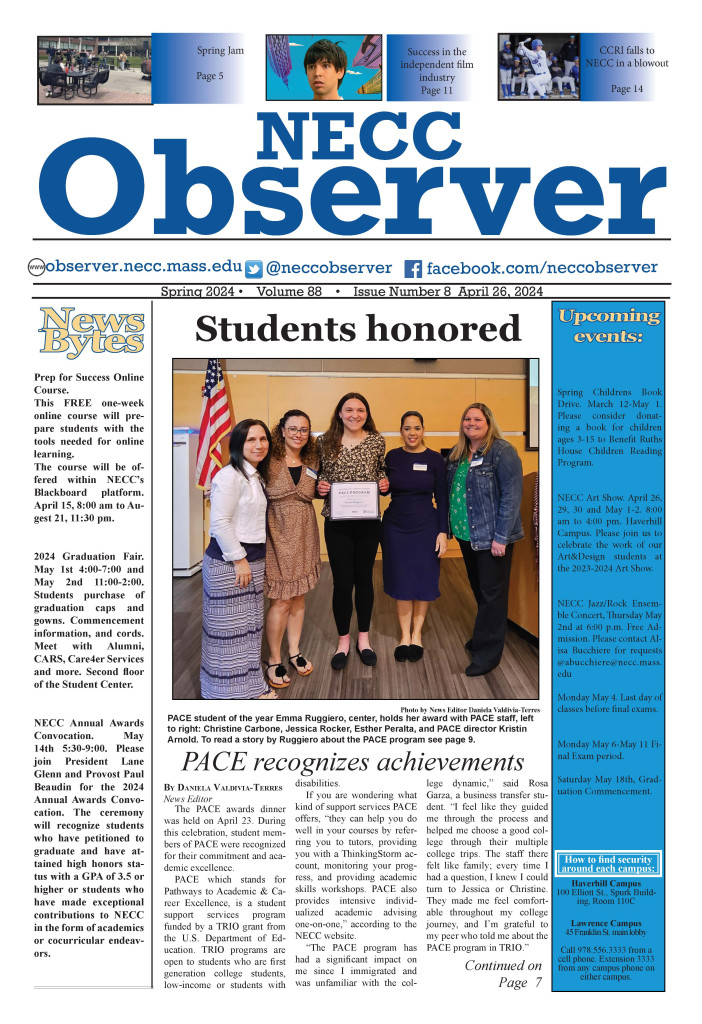On March 29, 2021, famous musician Lil Nas X released a scandalous new song entitled “Montero”, accompanied by a graphic music video and limited-edition pair of “Satan Shoes” created by MSCHF.
Due to the song’s satanic premise and demonic imagery of which has triggered much uproar within the religious community, the project has recently been a popular source of controversy throughout the media and entertainment industry.
After speaking with various NECC students about the matter, some are in full support of the musician’s creative expression, while others are not.
The song “Montero” itself includes many biblical references of which may be considered blasphemous, while the music video depicts Lil Nas X participating in sodomy with the devil. Other settings include his seduction by a serpent in the Garden of Eden and sliding down a stripper pole from heaven to hell. At the end of the video, Lil Nas X murders Satan by breaking his neck and placing Satan’s devil horns on his own head, thus becoming Satan himself. Concerning Lil Nas X’s “Satan Shoes”, only 666 pairs were exclusively created and sold for 1,018$ each—selling out within a minute of its initial release.
The custom design for the Nike Air Max 97’s is red and black, featuring a gold pentagram atop the lace front, the bible verse “Luke 10:18” at the heel, and a single drop of human blood contained inside the sole of the shoe, visible in a clear bubble on the outside.
Isa Grullon, 34, a journalism and communications major from Lawrence, stated that her opinion regarding Lil Nas X’s music is indifferent despite finding the song “Montero” to be catchy.
As she prefers listening to 90s music, “The song is not my preference, but I could see someone else being into it and that would not bother me,” said Grullon.
Regarding his music video, “They did a good job of using imagery to evoke feelings. The use of pastels to portray heaven and the stripper pole for hell was very symbolic and well done. It was also cool how he played every character, showing off his diversity,” said Grullon.
She further explained how, in her opinion, the video was meant to showcase Lil Nas X’s personal journey of being a black, gay man and public figure in modern society. She stated that his portrayal of becoming Satan in the end symbolizes his victory of self-acceptance as an underdog.
Concerning his expensive footwear, Grullon stated that she would rather spend the $1,018 on food.
“I don’t understand the shoes. To me, that’s an over-the-top publicity stunt to get a rise out of people. Plus, where did they get the human blood from? Was it donated?” said Grullon. She further explained how that, in her opinion, there is a fine line between creating art for self-expression and attempting to trigger a reaction from the public.
“It is not our place to tell others how to express themselves—as long as they’re not hurting anyone. No one is forced to see other people’s creations. For me, the sneakers are a bit much, but to each his own,” said Grullon
Serai Bogran, 19, a film major from Haverhill, explained how that as a Christian, she has become more aware of the satanic imagery and subliminal messages of which artists and celebrities may advocate and/or incorporate into their work.
She further stated that over the last few years, the discreetness of Satanism has lessened and is now more openly advertised and promoted throughout entertainment media than ever before. As the religious community totals a large portion of the public’s backlash and hate regarding “Montero”, Bogran stated that it saddens her to witness those who claim to be of the church harassing Lil Nas X for being gay.
“As a Christian, it is not our job to judge others, make them feel bad about themselves, or tell them that they’re going to hell. God doesn’t want us to hate on anyone. Being gay is not going to send you to hell,” said Bogran. She further explained how religious people who discriminate against the gay community are actually tainting God’s image. However, as a Christian, she does still find it unfortunate that Satanism is the way in which Lil Nas X chooses to express himself.
“I do not agree with what he has been posting lately and personally find the drop of blood situation to be very weird and creepy,” said Bogran. “The backlash, however, is not helping things at all, and is in fact only proving his point. If anything, we should be praying for him, loving him, and showing him support. We should be telling him in a respectful manner that what he is doing is not okay.”
Nisaly Gonzalez, 22, a liberal arts major from Haverhill, stated that although she does not listen to Lil Nas X often, she does still appreciate his creativity as an artist. “I thought that the video was pretty interesting, and the setting was cool. The song symbolizes him trying to make a statement about being free in your own skin,” said Gonzalez. Despite her personally liking the design of his “Satan Shoes”, Gonzalez stated that she will not be wearing them.
When asked about her opinions on Lil Nas X’s received media backlash regarding the “Montero” project, Gonzalez stated, “I don’t disagree with it because he is living his life the way that he wants to. I feel that artists should have the freedom to do whatever makes them happy.”
While many find the considered vulgar and satanic themes within the “Montero” project to be inappropriate and offensive, others view Lil Nas X’s creations as a work of art and freedom of expression.
Grullon, Bogran, and Gonzalez all concur that the way in which both the religious community and general public has responded to the artist and his project could have been handled and improved in more positive and uplifting ways.

